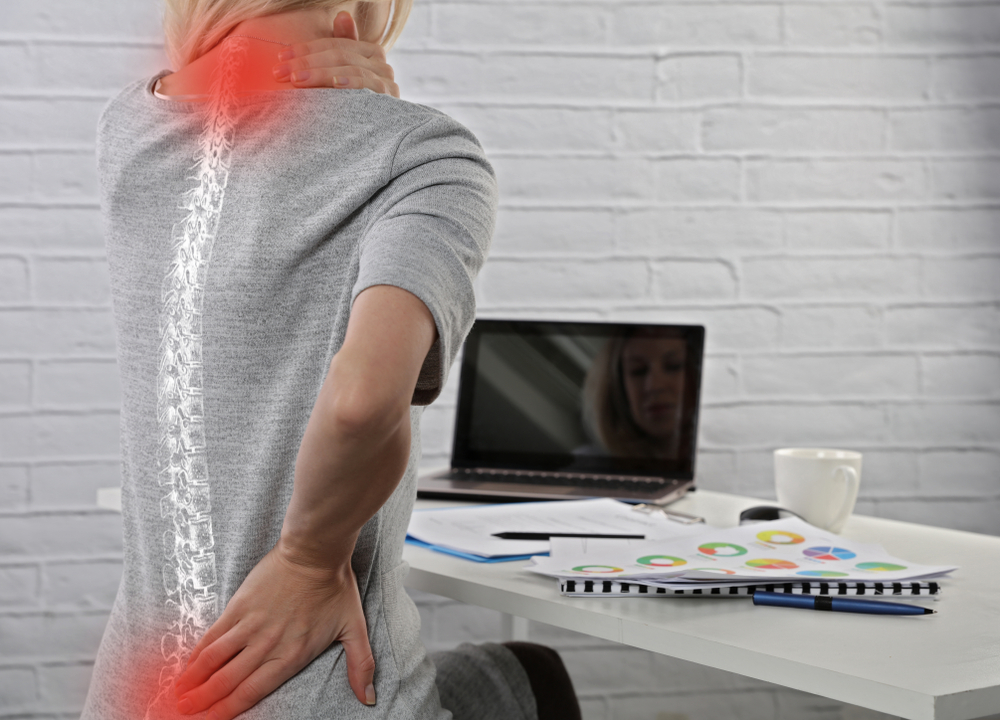Neck and back pain can be debilitating, making it hard for you to live your life and complete your day-to-day tasks.
Everything you do, from running errands to washing your dishes, can be easily impacted by your neck and back pain.
Most of the time, unless you have experienced a traumatic or serious injury, neck and back pain can be easily addressed and relieved.
The River Stone Wellness team is here to help you better understand what causes back and neck pain and how it can be treated.
Keep reading to learn more about managing your back and neck issues and relieving your pain:
What Causes Neck and Back Pain?
Neck and back pain causes can be apparent or underlying. The best way to determine what is causing your back and neck pain is to visit your doctor to determine a diagnosis.
From there, you can seek the best treatment for your unique needs!
But to give you an idea of what can cause neck and back pain, here are some common causes:
Poor Posture
Posture refers to how you position your body while sitting and standing—and having poor posture can lead to neck and back pain.
In a healthy and neutral position, your ears should be positioned directly over your shoulders with your chest open and your shoulders back. This minimizes stress on your neck by balancing your head’s weight on your spine.
However, holding your head too forward or slouching your back can cause pain in those areas by increasing stress on your spine and overworking the muscles in your neck and upper back.
Poor posture can also lead to hyperflexion and hyperextension, which occurs when the vertebrae of your spine tilt too far forward. This can cause your spinal cord and nerves to stretch and result in pain.
The longer you maintain poor posture, the more likely your neck and back will stiffen and hurt.
Muscle Tightness
Muscle tightness occurs when your muscles feel stiff, and it is more difficult to move around than usual. It may also cause muscle cramps, pain, and discomfort.
Muscle tightness typically occurs following hard physical work and exercise, but you can also experience stiffness following periods of inactivity.
Sprains and strains can also cause muscle tightness, as well as insect bites/stings, infection, and extreme heat or cold injuries.
While muscle tightness usually goes away on its own with rest and gentle stretching, it can be a sign of a more serious problem.
Medical treatment should be sought immediately if the muscle stiffness is accompanied by fever, extreme muscle weakness, redness, and swelling.
Injuries
The sudden onset of discomfort or pain in your back or neck could be caused by an injury such as a sprain or strain.
Overdoing it when it comes to exercise, moving the wrong way, or falling can easily cause neck and back injuries.
It’s important that you visit your doctor to determine if a neck or back injury is the cause of your pain. It will likely be recommended that you rest and limit your activity until the injury has healed.
More severe injuries may require further measures, such as physiotherapy or chiropractic care.
Other types of injuries that can cause neck and back pain include:
- Whiplash
- Fractures
- Muscle overuse
- Car accidents
- Sports accidents
How to get Relief from Neck and Back Pain
If you are seeking neck and back pain relief, you are in luck! Many treatment options are available to help you get rid of the pain and discomfort and go back to living your life.
Here are some common treatment options and ways to find relief:
Myofascial Release
Myofascial release is a type of manual therapy used in massage and manual osteopathy to focus on pain in the myofascial tissues – the membranes that support, wrap, and connect your muscles.
Myofascial pain originates in trigger points, so it differs from other pain types. These trigger points relate to anchored areas around your body that can become stiff and cause pain.
This type of therapy involves locating stiff and fixed areas of myofascial tissue to localize the cause of pain. Although these areas may not coincide with the area of pain, they can restrict muscle and joint movement around the body and cause back and neck pain.
The therapist will then use focused manual stretching, kneading, and pressure to loosen up the tight areas, work out knots, and reduce the pain.
Apart from neck and back pain relief, myofascial therapy can offer additional benefits, such as:
- Improved range of motion
- Overall relaxation
- Improved circulation
While you can easily include myofascial release as part of your self-care routine at home, it is recommended that you seek the professional and consistent services of a trained therapist.
Posture Improvements
Another way to seek neck and back pain relief is to improve your posture!
This all starts by learning how to sit properly. Nowadays, we live more sedentary lives than our ancestors, with most of us working jobs that require many hours of sitting.
Here are some ways that you can improve your posture while sitting:
- Sit with your feet on the floor to maintain a proper curve in your spine and lower back. Avoid crossing your legs.
- Ensure your chair is the proper height so that your hips are level with (or a little higher than) your knees.
- Sit in chairs that provide lumbar support or purchase a lumbar roll. This will help you maintain a straight and erect posture.
You can also improve the posture of your neck by avoiding a forward head position:
- Tuck your chin down and in, ensuring that your ears are positioned above your shoulders.
- Stretch your chest muscles daily to help your shoulders and head stay pulled back.
You can also try sleeping on a cervical pillow (an orthopedic pillow) to better support the natural curves of your head and spine during the night. Look for pillows that curve inward and provide you with ample comfort and support.
Physiotherapy
Physiotherapy is an effective treatment for neck and back pain. By combining hands-on treatment with exercises, physiotherapy can reduce pain and stiffness, prevent further issues, and improve your quality of life.
Some physiotherapy treatments for back and neck pain include ice and heat therapies, massage therapy, ultrasound, and electrotherapy to help relieve inflammation, stiffness, and pain.
Your physiotherapist will create a treatment plan that is unique to your needs and situation that includes any of the above treatments, as well as an individualized exercise and stretching routine.
Performing regular exercises and stretches can help strengthen your neck and back to relieve pain and prevent any issues from occurring in the future.
Chiropractic
Chiropractic is manual treatment that focuses on the joints of the spinal column and the surrounding soft tissues. Chiropractors can treat your neck and back pain by correcting any structural issues that may be causing pain, tingling or numbness.
A chiropractor will assess the nature of your pain or injury and provide treatment right away. They will also develop a treatment plan with you so that you know how your recovery will progress. Treatments may be weekly or twice weekly.
Wellness, Done Well!
At River Stone, we strive to provide the very best therapy to address your struggles and provide you with a relaxed and healthy life.
We will happily help you find a service and practitioner to suit your needs, so if you are looking for neck and back pain relief, don’t hesitate to get in touch!
Contact us for more information or book your appointment online.
We look forward to seeing you!


